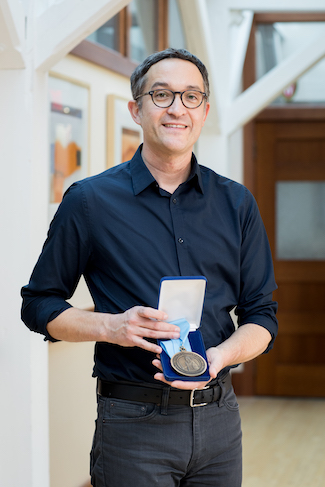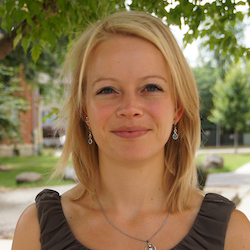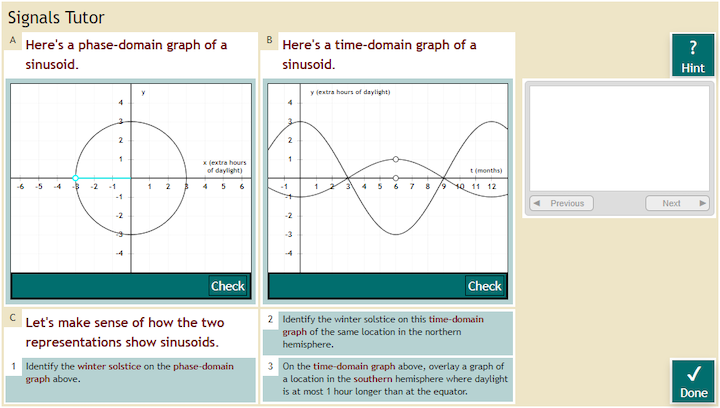Poler receives Leadership Award from Association for Tribal Libraries, Archives, and Museums
UW-Madison’s Omar Poler (Sokaogon Ojibwe) was honored this past fall with the Association for Tribal Libraries, Archives, and Museum’s 2019 Leadership Award.
 This award honors individuals with exceptional abilities to lead and inspire, as reflected in extraordinary accomplishments with broad impact on the field of indigenous culture. Poler was chosen for his “quiet strength, inclusionary spirit, and devotion to Great Lakes cultural institutions.”
This award honors individuals with exceptional abilities to lead and inspire, as reflected in extraordinary accomplishments with broad impact on the field of indigenous culture. Poler was chosen for his “quiet strength, inclusionary spirit, and devotion to Great Lakes cultural institutions.”
Poler is the American Indian curriculum services coordinator with the School of Education’s Teacher Education Center.
In 2010, Poler organized the first Convening Culture Keepers gathering of tribal librarians, archivists, and museum curators from Wisconsin, Michigan, and Minnesota. As a result of his leadership, participants were able to establish lasting partnerships with other tribal communities, resulting in meaningful contributions to the preservation of indigenous cultural heritage in the region.
Three years later, while serving as an outreach specialist with UW-Madison’s iSchool, Poler worked closely with leaders in tribal institutions to identify professional development needs, which culminated in multiple regional professional development institutes and a multi-year effort to develop a community co-curated traveling exhibition aimed at tribal youth.
Many of those Poler has worked with played a part in nominating him for this award, praising Poler’s ability to be patient and respectful while also exhibiting strong leadership. Janice M. Rice, Ho-Chunk nation elder and emerita librarian at UW-Madison shares, “He balances his knowledge of indigenous ways with goals of academia while remaining true to cultural preservation values that culture keepers have shared with him.”
“Indigenous cultures, languages, and histories have unparalleled beauty, power, and importance,” says Poler. “It is a profound honor to be recognized by so many American Indian cultural professionals working tirelessly every day in their communities to preserve, maintain, and revitalize them.”
Rau receives NSF award to examine ways to help students learn engineering concepts
UW–Madison’s Martina Rau this past summer received a federal grant to examine how instructors can better utilize visuals to help students learn complex engineering concepts.
The award of $300,000 is from the National Science Foundation’s (NSF) Improving Undergraduate STEM Education (IUSE) grant program.
 Rau is an associate professor with the School of Education’s highly regarded Department of Educational Psychology and the director of the Learning Representations and Technology Lab. She is partnering on this project with UW–Madison’s Barry Van Veen, the Lynn H. Matthias Professor with the Department of Electrical and Computer Engineering. His research interests involve statistical signal processing and its applications.The project being supported is titled, “Support for Individual and Collaborative Learning of Internal Visualization Skills for Complex Engineering Concepts in Active Learning Classes.”
Rau is an associate professor with the School of Education’s highly regarded Department of Educational Psychology and the director of the Learning Representations and Technology Lab. She is partnering on this project with UW–Madison’s Barry Van Veen, the Lynn H. Matthias Professor with the Department of Electrical and Computer Engineering. His research interests involve statistical signal processing and its applications.The project being supported is titled, “Support for Individual and Collaborative Learning of Internal Visualization Skills for Complex Engineering Concepts in Active Learning Classes.”
“I’m excited because this grant allows me to bring my research to a new domain,” says Rau. “My prior work has focused on visualization skills in chemistry, where visuals remain present throughout instruction. The use of visuals in engineering is different because visuals are often used to introduce new concepts, and subsequent instruction relies on students’ ability to internally visualize or imagine the visuals. I look forward to investigating how we can present visuals in ways that will help students imagine the visuals when they are no longer present.”
Rau explains how engineering instructors often use visuals — such as Cartesian and polar coordinate graphs — to help students learn. And while it’s often assumed that such visuals help students learn because they illustrate complex concepts, such representations can also be confusing unless students know how the visuals show information.
“Learning with visuals, and especially imagining visuals, is particularly difficult for students who have low spatial skills, and this group of students is often at a disadvantage in STEM,” says Rau.
The goal of this project, the researchers explain, is to help students learn with visuals when they work alone and in teams.
“Visual thinking and problem solving is an essential skill in engineering,” says Van Veen. “Many students seem to struggle because they do not ‘see’ the correspondence between visual representations and the mathematics associated with engineering concepts. While instructors use visual representations extensively, they don’t directly address the lack of representational skills at the root of student difficulties. I’m enthused about directly teaching and developing these skills because I believe it will help students be more successful in school and in engineering careers.”
As part of this work, the research team will create an educational technology called Signals Tutor for an engineering course on signals processing. Rau explains that Signals Tutor allows students to construct visual representations of engineering problems (see figure at bottom of page).
“When students make a mistake, the technology will give error-specific feedback designed to help students construct an appropriate visual representation,” says Rau. “The technology also adapts to students’ problem-solving skills by selecting problems of an appropriate difficulty level for students to work on.”
An additional focus of this technology, Rau explains, will be to help students imagine the visuals when they are no longer present. These “internal” visualization skills will help students learn from text and equations.
The research team will then conduct a series of experiments to examine how best to combine supports for sense-making and fluency so that they improve students’ internal visualization skills as well as their learning of new content knowledge.
Additional work will examine whether students who tend to struggle with visuals, for example, because they have low spatial skills, particularly benefit from support for sense-making and fluency.
The experiments will be carried out in learning situations where students work individually and collaboratively. This will allow the project team to establish which aspects of visuals are best learned alone or in a team.
Further research will be conducted at two-year and four-year colleges to ensure that the findings enhance learning of a diverse student population.
Rau adds that while the project focuses on learning of foundational engineering concepts, it may yield lessons that will inform the development of educational technologies for other disciplines.
